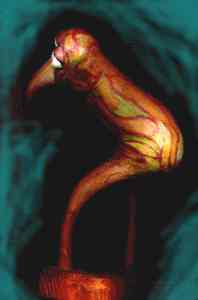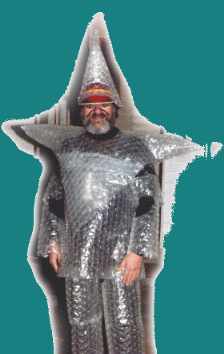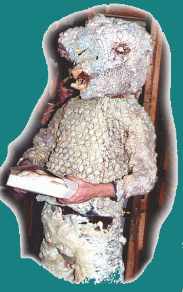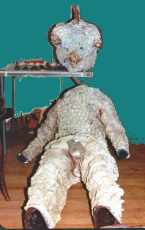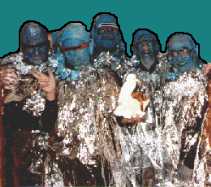
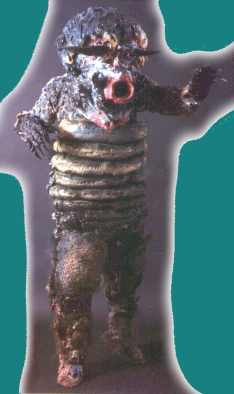
Hey this is a small list. It's not even a listing of a lot of titles I am aware of. You will notice for instance that I haven't listed any Star Trek movies. Not that I didn't enjoy them, but my selections are for no other reason except that my memory has been strongest on them. Or else I just couldn't ignore them....
The Day the Earth Stood Still (1951) Directed by Robert Wise. Harry Bates's short story "Farewell to the Master" was adapted by Edmund North. The alien Klaatu arrives to warn us humans that we are about to destroy our planet. The repercussions of this message still ring loud and clear. Only by having this message relayed to his is robot, Gort is he able to succeed, "Gort, Klaatu barada nikto" Many a kid memorise this message in case the need ever arrises.
Robby the Robot was introduced in the 1956 movie "Forbidden Planet." He returned in 1957's The Invisible boy. His classic features appeared in many tin toys of the peried and were recast in Lost in Space as well as others.
"2001: Space Odyssey" (1968) Hal obviously didn't learn Asimov's rules of robotics. This very enigmatic film tells the story of mankind, often without words. The real star is the deeply-disturbed computer Hal. Stanley Kubrick produced, directed and co-wrote the screenplay with Arthur C. Clarke.
Buckaroo Bonzai: If you like comic books, rocket science, nuclear physics and music this movie was made for you. (It certainly was for me.) Peter Weller plays Buckaroo, who has to fight the twisted Dr. Emilio Lizardo (John Lithgow). Other notable actors include Ellen Barkin (Penny Pretty), Jeff Goldblum (Jersey), and Christopher Lloyd. Verse yourself on War of The Worlds first. And did I mention that the good aliens look and talk like rastafarians.
Dr. Emilio Lizardo: "Laugh while you can, monkey boy!"
Buckaroo Bonzai: "Remember, no matter where you go...there you are."
As of 1999, Steven Spielberg had 4 of the ten top-grossing films of all-time. "E.T." (1982), "Close Encounters of the Third Kind" (1977), "Jurassic Park" (1993) and "Poltergeist" (1982).
Little Shop of Horrors (1986) What happens when you take a classic grade-B movie Subtract the "The" and add music
Directed by Frank Oz, The original screenplay was written by Charles B. Griffith (1960) and adapted with song lyrics by Howard Ashman. The music was written by Alan Menken
A nerdy florist gets his chance for success and romance. All he has to do is feed a giant man-eating plant. Levi Stubbs Jr (basso for The Four Tops) is the voice of the plant, Audrey II . Rick Moranis is Seymour the nerdy florist who gets to sing, " Suddenly Seymour is right there beside her ...".
Steve Martin almost steals the show as the evil dentist, Orin Scrivello. James Belushi, John Candy, and Bill Murray are among the SNL alumni to appear. The original film was directed by Roger Corman with the alternate title of The Passionate People Eater (1960)
Godzilla ... From1954 to 1999 the 20,000 ton, fire-breathing lizard-monster has wreaked havoc in 25 movies. It all started with atomic testing on a remote Japanese island. Having endured 2 nuclear bombs, it is possibly not surprising that the Japanese have speculated on the consequences of such a powerful weapon.
UFOria (1981) comedy with Cindy Williams (Shirley of L&S) & Harry Dean Stanton. Scam artists looking to cash in on ufo fever with religious ferver. Will the aliens actually come? I'm not telling...
Star Wars - One of the things that George Lucas demonstrates over and over again is that the special effects are secondary to the story and the dialogue. Still his attention to detail is legendary. Lucas, with his world-famous Industrial Light and Magic special
effects company and Skywalker Sound state-of-the-art recording studio has revolutionized the ways that films are made.
"These are not the droids you are looking for." - R2-D2 and C3PO were modeled after two peasants in a Kirosawa movie. Even with his incomprehensible language of beeps and whistles R2-D2 still manages to hold center stage.
Brother From Another Planet (1984) Written and directed by John Sayles. A mute black extraterrestrial (Joe Morton) flees alien cops. Think 19th century slave fleeing on the underground railroad. I hope I didn't give too much away, but it's a great concept.
Edgar Allen Poe is considered one of the main architects of science fiction, because of his emphasis on scientific plausibility. "Hans Pfaal"(1835) is one of the first scientifically serious tales of space flight. Other of Poe's science fiction stories include "The Balloon Hoax" (1850) "The Conversation of Eiros and Charmion", the first end of the world story, "A Tale of the Ragged Mountains", may be the first story of physical time travel
Jules Verne is the first novelist to specialize in science fiction.
He explored subterranean and underwater space as well as outer space.
"Journey to the Center of the Earth" (1864)
"From the Earth to the Moon" (1865)
20,000 Leagues Under the Sea (1870)
H.G.Wells used science fiction to explore his beliefs in socialism, feminism and evolutionism. Wells prophesied aerial warfare and the atomic bomb ("The War in the Air," 1908; "The World Set Free," 1914)."Time Machine" (1895), "The Invisible Man" (1897), "War of the Worlds" (1898)
Aldous Huxley (1894-1963) "Brave New World" (1932) describes a tyrannical Utopia based on a biologically engineered caste structure. (Often compared to Orwell's "1984." ) Huxley's "Brave New World Revisited" (1958) exposes the author's fear that his predictions were becoming reality sooner than expected.
Isaac Asimov (1920-1992) was not only a science fiction writer, but a scientist and science writer as well. He was a biochemist. He published his 300th book, "Opus 300," in 1984. He coined the word "robotics" and tried to instill a sense of morality into the world of scientific developments. He created the following Laws of Robotics ...
Robert A. Heinlein (1907-1988) Liberation of the individual from the confines of culture, hypocrisy of organized religion and the madness of mysticism. The prolific American novelist drew on these issues in most of his 45 novels, which included "Double Star" (1956), "Starship Troopers" (1959), "Stranger in a Strange Land" (1961) and "The Moon is a Harsh Mistress" (1966). Stranger in a Strange Land became something of a cult classic in the late 1960s as "hippies" rebelled against contemporary cultural restraints and tried to redefine society, where the individual could gain control over the environment and build a better world. n "Stranger in a Strange Land" Michael Valentine Smith, born of earth parents is raised by martians to a near superhuman ability to transcend and manipulate matter.The term "grok" became popularized from this hippy bible. This word would indicate that once you understood the very nature of a substance or event, you could control or manipulate it with the power of your mind.
Ray Bradbury (b. 1920) The U.S. author's 1950 novel "The Martian Chronicles" describes man's first attempt to conquer Mars -- reflecting American anxieties about the atomic age, racism and censorship. "Fahrenheit 451" (1953) is probably Bradbury's best-known work, set in a futuristic totalitarian state where the written word is forbidden.
Arthur C. Clarke (b.1917) As a young man, this British sci-fi guru predicted a system of "rocket stations" orbiting the Earth for communications purposes -- such satellites are now taken for granted. Best known for his space novel "The Sentinel" - which Clarke also adapted into a screenplay titled "2001: A Space Odyssey" for film director Stanley Kubrick. Clarke's 1996 novel "3001: The Final Odyssey" explores cyberwarfare and micro-chip technology able to store human memories.
Frank Herbert is responsible for another shift in sci-fi history when "Dune" was published in 1965. It's an intricate story of humans controlling the fates of thousands of planets. One of the important scientific parables that Dune illustrates is the necessity to understand the environmental and ecological balance within any system.
Baron Harkonnen, "he who controls the Spice, controls the universe..."
Ursula K. LeGuin (b. 1929) The popular Californian fantasy writer dishes up anarchical and androgynous themes in her contemporary novels. Best-known works: "Rocannon's World" (1966), "The Left Hand of Darkness" (1969), "The Farthest Shore" (1972), "The Dispossessed" (1974), "Malafrena" (1979), "The Compass Rose" (1982) and "Earthsea" trilogy (1990).
Kurt Vonnegut Jr. is probably in a class by himself. Or at least in a class with Mark Twain and Jonathan Swift. His use of science fiction is almost incidental to his social commentary.
Marion Zimmer Bradley: Any of the Darkover series. I tease Flo by referring to these works as "neo-pagan feminist sci fi.".
Douglas Adams: "Hitchhiker's Guide to the Galaxy". I heard Douglas Adams give this advice in hindsight about the book, "Never destroy your homeplanet in the first chapter." Zaphod Beeblebrox This guy knows how to boogie. The President of the Galaxy is a weird, fun-loving party-animal alien from Betelguese who has two heads and three arms and a space ship with an Infinite Improbabilty Drive that does "really wild things."
Immanuel Velikovsky "Worlds in Collision"(1950s) and Eric Von Daniken, Chariots Of The Gods? (1960s?) ... Both of these writers consider their work scientific. Because they question outside the established scientific notions, they belong on the reading list of sci-fi lovers. While their works may not be taken seriously by most scientists, they both offer insight into different ways of viewing the earth's past.
My intention was to give a very, very, very brief overview of sci-fi. A page of this sort is bound to miss more targets than it hits, but here's a few more authors and titles that I just couldn't ignore. ...
Nathaniel Hawthorne:Dr. Heidegger's Experiment (1837), "Rappaccini's Daughter" (1844, 1846)
Robert Louis Stevenson "The Strange Case of Dr. Jeckyll and Mr. Hyde"(1896),
Sir Francis Bacon, Johannes Kepler, Peter Wilkins, Ludwig Holberg, Mercier, E.T.A. Hoffmann, Godwin,Mercier, Washington Irving,Edward Bellamy, Rudyard Kipling, Mark Twain ...
In 1928, Buck Rogers was introduced in Amazing Stories Magazine. In 1929 he appeared in comic strips, in 1932 on the radio and in movies in 1932. Flash Gordon was created in 1934 to compete and cash in on the popularity of Buck Rogers. While TV sets didn't appear in people's homes until the 1950's, Ming the Merciless (Flash Gordon's nemesis) wa able to watch his TV screen in the 1930's. But you had to go to the movies to see it.
Besides magazines, there were comic books and it's cousin the Big Little BookŪ. Comic books started out as comic or cartoon strips in 1896. These evolved into books by the 1930s
In 1932 the Big Little BookŪ was first published by the Whitman Publishing Company. Many other publishers followed this trend. Most were 3 5/8" x 4 1/2" x 1 1/2" and 432 pages in length. There was a captioned picture opposite each page of text. The source material for the books was drawn mostly from radio, comic strips, and motion pictures.
SCI FI LINKS
|
|
What do SciFi & music have in common?
This is the place to contact us |
A note on sources. I tried to add relevant links to sites that I found most helpful in assembling this information. There is a lot of duplication on some of this information. It wasn't originally my intent to write a chronology of this sort, but I didn't find one synopsis that I found complete enough. I apologise if I missed the original sources of some of this information. Please let me know and I'll gladly correct.
Melody, Lyrics and pictures © 1998, 1999 by R.& F. Newman except where noted. Please contact us if you'd like to reproduce any portion.
